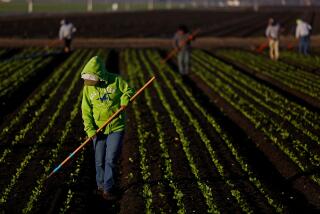Northeast’s Farmers Survive by Scrambling to Resist Pressures
LEOMINSTER, Mass. — The weather had cooled a bit and the season was winding down, so Warren Gove, a farmer known for his extraordinary tomatoes, had time to talk--although he was thoroughly perplexed.
“There’s no news here. We’re just making a living,” Gove said.
That, in fact, is the news in the Northeastern United States. Agriculture here has plenty of problems, but the economic crisis of the 1980s that has bankrupted tens of thousands of farmers elsewhere has largely bypassed this part of the country.
Unlike the troubled Midwest Farm Belt, agricultural land prices have remained high because of intense development pressure. Climate, steep terrain and small farming tracts have required farmers to diversify and scramble to stay in business. And a huge urban population assures that virtually every carrot, every drop of milk, every bunch of herbs will find a ready market.
Number of Farms Rising
Throughout the Northeast, small-scale agriculture is undergoing a resurgence--the number of farms actually is increasing--due to growing consumer interest in fresher food and to innovative state programs designed to keep farmers on the land and to make consumers less reliant on food imports.
“They have 55 million people in 12 states--that’s the key,” said Howard W. (Bud) Kerr, small-farms expert at the Agriculture Department in Washington. “The Northeast is one of the few places where they’re doing something--it’s not all that talk about more exports. It’s what you can do at home and do well.”
Vegetable grower Gove’s experience is a case in point.
Although he and his son, Paul, farm about 50 acres--a drop in the bucket for a Midwestern grain farmer--they live comfortably by selling almost everything they grow from a roadside stand at the edge of their property.
Innovation at Work
They build some of the special equipment they need for vegetables; Gove has pioneered techniques that keep tomatoes alive long after frost has stopped other farmers. He’s expanding his greenhouses to meet the increasing demand for profitable bedding plants.
“Transplant me to Iowa and I’d do no better than they are,” Gove said. But as he talked, the spirit of innovation and the willingness to live within his means--traits shared by many farmers in the region--punctuated his remarks and bespoke success.
Worcester County extension agent Alden Miller, a transplanted Midwesterner, put it this way: “Warren Gove has one of the best farms in New England. He is innovative. He can make more profit from 5,000 tomato plants than growers with 48,000 plants. I was used to large-scale farming when I came out here . . . but big is not the way to go in New England. The farming is more intensive here, and if you’re good, you’re doing well.”
Here in the Northeast, many farmers have learned the lesson of survival. As Kerr put it: They must adapt and take advantage of local marketing opportunities. If that means sweet corn and squash instead of easier-grown barley and soybeans, so be it.
Preserving Farm Land
And, contrary to a widely held belief that only Washington holds the keys to agricultural prosperity, the states of the region are finding new and catchy ways to stimulate local farm production and preserve farm land under intense development pressure.
New Jersey and New York, for example, spend more than $1 million a year to promote locally grown foods. Vermont’s aggressive program promoting the “Vermontness” of local food products is so successful that a shortage of raw materials exists. Connecticut promotes its own produce; Maine farmers so long reliant on the potato are expanding into other vegetables such as broccoli to tap the regional markets.
In New Hampshire, where the state encourages farmers to diversify, dairy farming has been displaced from its traditional No. 1 position by vegetable growing and nursery production, much of it sold directly to consumers at elaborate farm stands.
A textbook for success is being written by Richard Clark Jr., who gave up dairy farming near Bedford, N.H., nine years ago and created a vegetable and flower operation that draws national attention. Clark’s produce is sold from a handsome stand on a remote side road. His innovations produce tomatoes that ripen earlier and later than most others in forbidding New England weather, and his retail flower output is the state’s largest.
Land Costs Rocket
But Clark and his family are strapped by the same dilemma facing other farmers in the region. They are increasingly hemmed in by urban development, and skyrocketing land costs make it impossible to expand.
The pressures have become so intense that Clark’s oldest son, Dickie, is uncertain about the farm’s future. A neighboring, 60-acre dairy farm was sold to developers last year for $1.2 million. At those prices, the Clarks cannot think of expansion.
“The land pressures are such that they may force us to go to greenhouse operations only. But in order to survive we have to be diversified,” Dickie Clark said. “It kills me--all this agricultural land being developed and it can’t be returned to farming. Agricultural production here will be a necessity in the future. But there’s no concern now about where the food will come from.”
“There are staggering opportunities for marketing in this region,” said Steve Taylor, New Hampshire’s agriculture commissioner. “And all kinds of young people want to do these things. . . .We used to think of farm stands as a piece of plywood on two sawhorses. Now they are like supermarkets, and the supermarkets have countered by tripling the size of their produce departments.”
State Programs Help
The premier agricultural promotion schemes may belong to Massachusetts, where Gov. Michael S. Dukakis and two hyperactive agricultural commissioners in the last decade have launched several programs designed to bolster farming, ensure more food self-sufficiency and relieve environmental pressures.
“Pesticide drift and pollution of groundwater and urban development are our biggest problems,” said August (Gus) Schumacher Jr., appointed by Dukakis as food and agriculture commissioner in 1985. “But the sheer prosperity of our state is overwhelming agriculture. Farmers are just not sharing in the general prosperity, even though their 1978 pickup trucks are fully paid.”
Dukakis and Fred Winthrop, who preceded Schumacher in the job, decided in the mid-1970s that the state had to step in forcefully to halt the rapid decline in the number of farms, which had dropped from about 35,000 to 4,500 in 30 years.
“They said, ‘That’s enough,’ and they put together a farm policy that included aggressive promotion of Massachusetts agriculture and farm-land protection measures,” Schumacher said.
Promotions Abound
Schumacher, a former World Bank economist and truck farmer who paid his way through Harvard by growing Indian corn, has kept the ball rolling. He talks farming comfortably, knows many constituents on a first-name basis and is on the road constantly.
More to Read
Sign up for Essential California
The most important California stories and recommendations in your inbox every morning.
You may occasionally receive promotional content from the Los Angeles Times.










